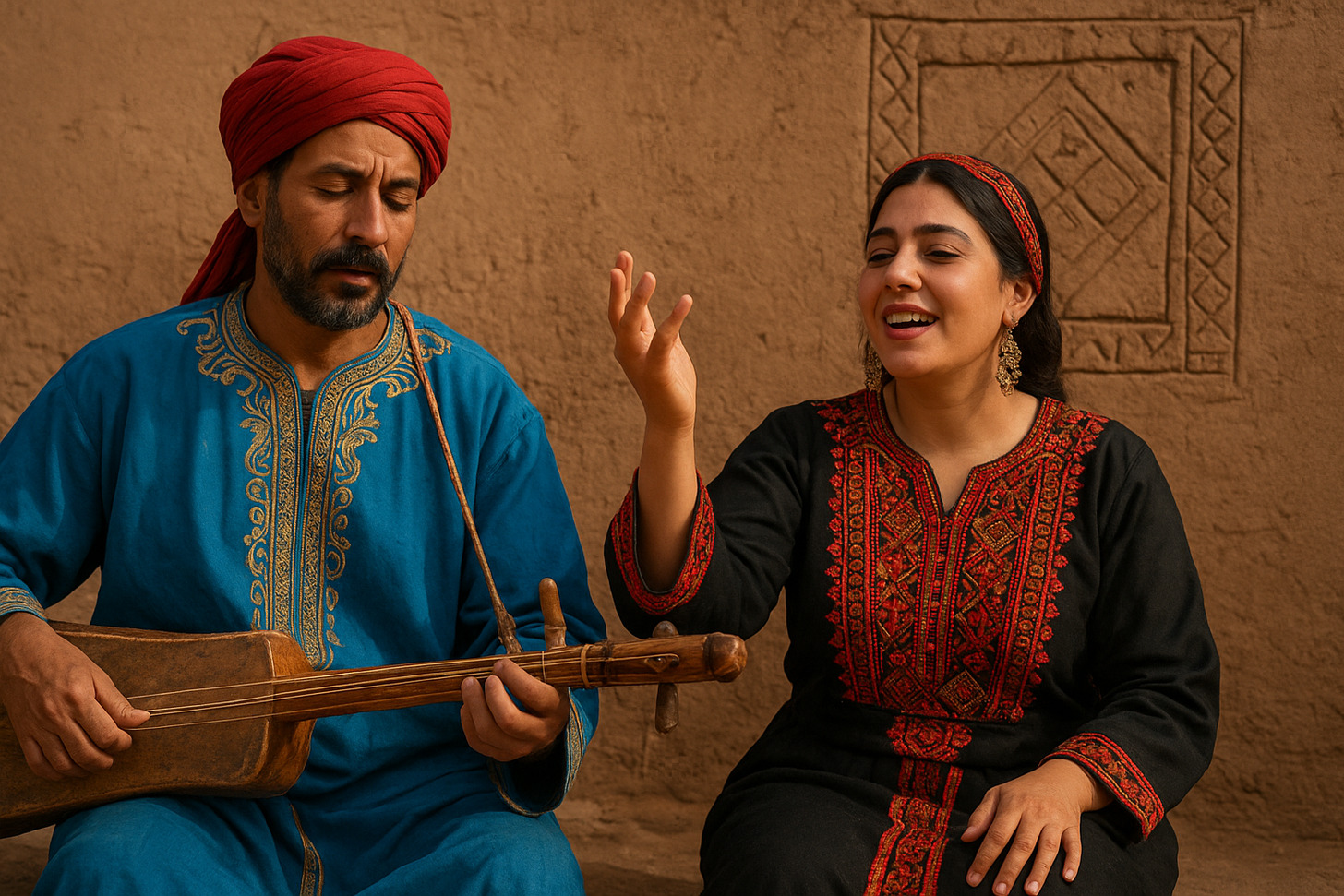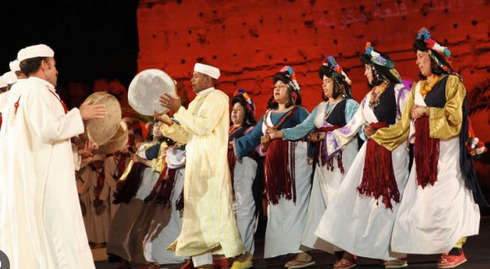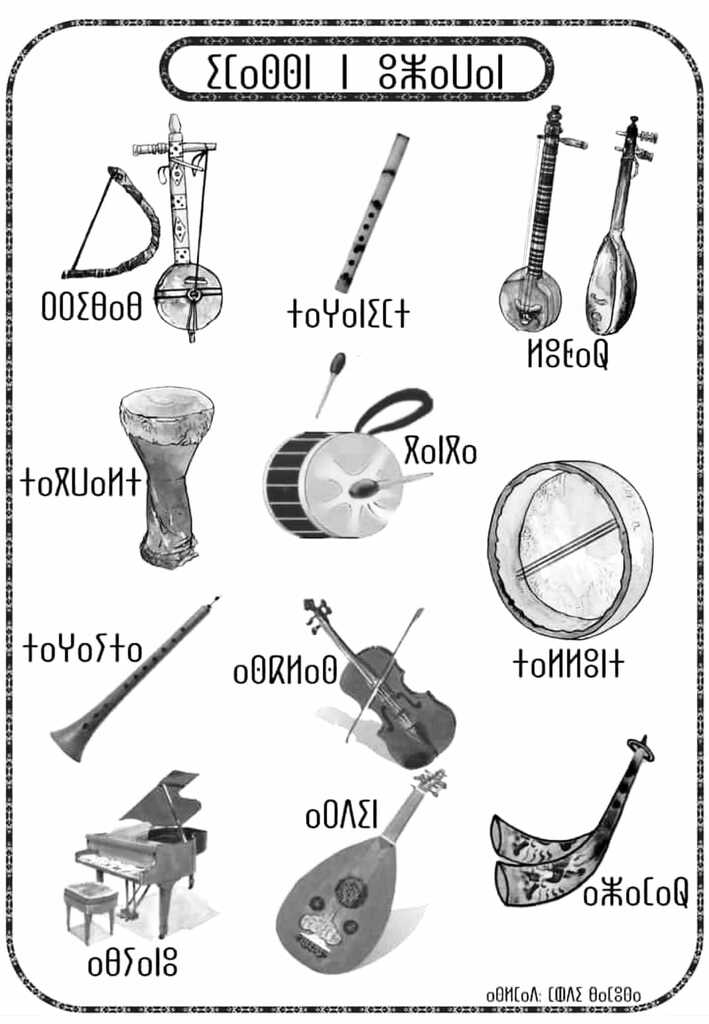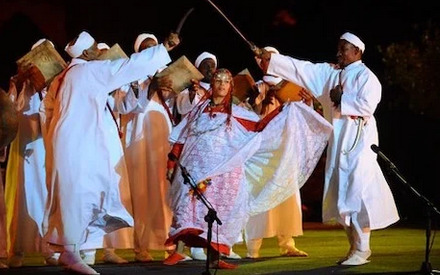Amazigh Music and Moroccan Folklore: A Rich Cultural Heritage
Amazigh music and Moroccan folklore, what two precious treasures in our heritage. Imagine those melodies that carry within them the stories of our ancestors, telling the story of an entire people. They are not just notes being played, but the pulse of life in our ancient Moroccan culture.
Every time I hear those rhythms, I feel as if I am traveling back in time, to the mountains and deserts where these melodies were born. It is music that carries in every note a memory, and in every word a story.
I cannot imagine our Moroccan identity without this beautiful musical heritage.
It is a part of us, like the air we breathe, like the ground we walk on.

A Historical Look at Moroccan Musical Heritage
Amazigh music in Morocco has a very long history, spanning thousands of years. Imagine how many generations have passed while carrying these melodies and developing them. It has always been influenced by other surrounding cultures, while at the same time leaving its mark on them. This continuous interaction between different cultures in the region is what made this music so rich and diverse.
The Roots of Amazigh Music Through the Ages
Amazigh music is not just fleeting melodies, but stories that carry within them a long history. Since ancient times, these melodies have been an integral part of their lives, resonating in their sacred rituals and happy occasions. Imagine how the sounds would rise in the air during those celebrations, like a thread connecting the past with the present.
The Old Era and Early Influences
During the old era, Amazigh music was influenced by surrounding cultures such as the Phoenicians and Romans. These influences contributed to shaping the first characteristics of Amazigh music.
Development of Amazigh Music During the Middle Ages
Amazigh music, those melodies that tell tales of ancient times, underwent a remarkable transformation during the Middle Ages. With the arrival of Islam in the region, new melodies began to flow into the ancient musical heritage, like colors added to an antique painting. It was not merely a superficial change, but rather an encounter between local authenticity and external influences that brought with them a different spirit. The melodies that were once played in the mountains and valleys could now be heard in the cities as well, carrying with them new stories and musical instruments that were previously unknown.
Amazigh music has become richer, like a river that gathers the waters of different tributaries to flow into one sea.
The Development of Moroccan Folklore and Its Various Influences
Moroccan folklore has been influenced by multiple cultures, leading to its diversity and richness.
Andalusian and Arabic Influences
The Andalusian and Arab influence played a major role in shaping Moroccan folklore, especially in the field of Andalusian classical music.
Interaction with African and Mediterranean Cultures
Moroccan folklore was also influenced by African and Mediterranean cultures, adding new dimensions to it.
In the following table, we review some of the main influences on Amazigh music and Moroccan folklore:
| Time Period | Cultural Influences | Musical Elements |
|---|---|---|
| Ancient Era | Phoenicians, Romans | Traditional musical instruments |
| Middle Ages | Islamic Conquests | Musical modes (Maqamat) |
| Modern Era | African and Mediterranean influences | Rhythms and musical styles |
Essential Elements of Amazigh Music
Amazigh music is characterized by its distinctive rhythms and unique musical modes, making it rich and diverse.
The Distinctive Rhythms of Amazigh Music
Amazigh music is characterized by its multiple and sometimes complex rhythms, which reflect the cultural and geographical diversity of Amazigh regions. These rhythms are used in various traditional occasions and celebrations.
Amazigh Maqams and Musical Scales
Amazigh music relies on unique musical maqams, some derived from Arabic maqams, while others are distinguished by their own particular character.
Singing and Vocal Performance in Amazigh Heritage
Singing is considered an essential part of Amazigh music, used for storytelling, expressing emotions, and celebrating important occasions.
Traditional Singing Techniques
Traditional singing techniques in Amazigh music are characterized by diversity, with extensive use of various vocal styles, such as loud and soft singing.
Group Performance Styles
Group performance is a distinctive feature of Amazigh music, where everyone participates in singing and dancing, enhancing the sense of community belonging.
| Element | Description |
|---|---|
| Rhythms | Diverse and complex, reflecting cultural diversity |
| Musical Modes | Unique and sometimes derived from Arabic modes |
| Singing | Essential part, used for storytelling and expressing emotions |
Regional Diversity in Moroccan Folklore
The geographical diversity of Morocco reflects a rich cultural diversity in folklore, with each region having its distinctive artistic characteristics.
This diversity is clearly evident in the music and folk dances, which vary from one region to another.
Rif Music and Northern Morocco
Rif music in northern Morocco is characterized by its unique style that reflects the Amazigh culture of the region. The most prominent features of this music include:
Characteristics of Iznasen Music
Iznasen music is considered one of the most famous musical styles in the Rif region.
It is characterized by its lively rhythms and distinctive melodies, often accompanied by traditional instruments such as the drum and the flute.
Rural Singing Styles
Rural singing varies between emotional and enthusiastic songs, which often express people's daily lives and challenges.

Music of the Middle Atlas and High Atlas
The regions of the Middle Atlas and High Atlas are characterized by music with a strong character rooted in Amazigh traditions.

Music of Sous and Southern Morocco
The Sous region and southern Morocco are characterized by music with a desert character, where the influences of the Great Sahara appear in the melodies and rhythms.
Ahwash Traditions in Sous
Ahwash are important musical and dance traditions in the Sous region.
This dance combines dancing and singing and expresses important social occasions.
The Sahrawi Musical Character
Sahrawi music in southern Morocco is characterized by a nomadic style, where the songs reflect the life and challenges of the nomads.
| Region | Musical Characteristics | Instruments Used |
|---|---|---|
| Rif and Northern Morocco | Lively rhythms and distinctive melodies | Drum and Nay |
| Middle Atlas and High Atlas | Strong character rooted in traditions | Drum and Rabab |
| Souss and Southern Morocco | Sahrawi character and varied rhythms | Tar and Oud |
Traditional Musical Instruments in Amazigh Heritage
Traditional musical instruments are an integral part of the rich Amazigh heritage.
Traditional Wind Instruments
Traditional wind instruments are used in Amazigh music to produce distinctive sounds. Among these instruments:
Nai and Qasba
The Nai and Qasba are common instruments in Amazigh music. The Nai is a wind instrument that produces a beautiful and varied sound, while the Qasba is often used in folk songs.
Zamar and Ghayta
The Zamar and Ghayta are other wind instruments used in Amazigh musical heritage.
These machines are known for their ability to produce powerful and distinctive sounds.

Rhythm and Percussion Instruments
Rhythm instruments play an important role in Amazigh music, as they are used to add rhythm and movement to songs and dances.
Bendir and Daf
The Bendir and Daf are the most famous rhythm instruments in Amazigh music.
These instruments are used in many traditional celebrations and occasions.
Qraqeb and Drums
Qraqeb and Drums are another rhythmic instrument used to add a strong and distinctive tone to Amazigh music.
Amazigh String Instruments
String instruments are an essential part of Amazigh musical heritage, used to produce beautiful and expressive musical sounds.

Combari and Rebab
Combari and Rebab are famous string instruments in Amazigh music. These instruments are used in many folk songs and poems.
Loutar and Kanbari
Loutar and Kanbari are another string instrument used in Amazigh musical heritage.
These machines are known for their ability to produce deep and impactful sounds.| Type of Instrument | Examples of Instruments | Common Use |
|---|---|---|
| Wind Instruments | Ney, Qasaba, Zumar, Ghayta | Folk songs and celebrations |
| Percussion Instruments | Bendir, Daf, Qraqeb, Drums | Traditional dances and celebrations |
| String Instruments | Kamri, Rabab, Lutar, Kanun | Folk songs and poems |
Forms of Dance and Movement Expression in Moroccan Folklore
Amazigh dances emerge as a fundamental element in expressing the cultural identity of local communities. In Morocco, forms of dance and movement expression vary, reflecting the rich cultural diversity of different regions.

Ahwash: The Dance of the Atlas Mountains
Ahwash is considered one of the most famous dances in the Atlas Mountains region. This dance is characterized by dancers gathering in a large circle, performing synchronized movements to the musical rhythms.

Structure and Formation of Ahwash Dance
Ahwash dance consists of a group of male and female dancers standing in a circle. The dance starts slowly and then accelerates over time, accompanied by group singing and strong rhythms.
Traditional Occasions for Performing Ahwash
Ahwash dance is typically performed on important occasions such as weddings and seasonal celebrations.
This dance is a means of expressing joy and celebration.
Ahidous: The Heritage of the Middle Atlas
The Ahidous dance is characterized by being more calm and contemplative compared to the Ahouache.
Ahidous is typically performed in circles, where dancers make consistent circular movements.
Other Distinctive Dances in Amazigh Regions
In addition to Ahouach and Ahidous, there are many other dances that characterize the different Amazigh regions.
The Kadra and Rekda Dances
The Sous region is famous for dances like Kadra and Rekda, which are characterized by their dynamic movements and strong rhythms.
Ritual and Seasonal Dances
There are also ritual and seasonal dances associated with specific times of the year or particular religious and agricultural occasions.
Thus, we see that dance plays an important role in expressing cultural identity and celebrating various occasions in the Amazigh regions.
Pioneers of Amazigh Music and Moroccan Folklore
Pioneers of Amazigh music have played an important role in reviving Morocco's artistic heritage.
The Founding Artists of the Amazigh Musical Movement
The founding artists played a prominent role in shaping the Amazigh musical movement. Among the most prominent of these artists:
Mohamed Rouicha and His Role in Reviving Heritage
Mohamed Rouicha was one of the most prominent artists who contributed to reviving Amazigh musical heritage. His artistic works had a significant impact in introducing the public to traditional Amazigh music.
Amouri M'barek and His Artistic Contributions
Amouri M'barek also played an important role in developing Amazigh music.
His artistic contributions helped expand the audience for Amazigh music.Famous Musical Groups and Their Contributions
In addition to individual artists, musical groups played an important role in promoting the Amazigh music scene.
Idir Group and Its Influence
The Idir group was one of the leading groups in the field of Amazigh music. Their unique musical style helped attract many music lovers.
Iznaren Group and Musical Innovation
The Iznaren group also had a significant impact on renewing Amazigh music. Their musical works presented a modern vision of Amazigh heritage.
The Role of Women in Preserving Amazigh Musical Heritage
Amazigh women played an important role in preserving the Amazigh musical heritage and passing it on to future generations.
Fatima Tabaâmrant and Her Artistic Leadership
Fatima Tabaâmrant was one of the first women to emerge in the Amazigh music scene.
Contemporary Artists and Their Contributions
Currently, there are many Amazigh female artists who continue to preserve and develop Amazigh musical heritage.
Fatima Tabaâmrant:
Samira Al-Murdi:
.Hada Ouakki:
Amazigh Music and Moroccan Folklore: The Social and Cultural Role
Amazigh music is a mirror that reflects the cultural values and meanings of Moroccan society. It plays an important social and cultural role in traditional occasions and celebrations.
The Role of Music in Traditional Occasions and Celebrations
Amazigh music is an integral part of weddings and family occasions.
Music in Weddings and Family Occasions
At Amazigh weddings, music and traditional dances such as "Ahwash" and "Ahidous" are used to create a celebratory atmosphere. These activities not only enhance joy but also strengthen social bonds among community members.
Seasonal and Agricultural Songs
Seasonal and agricultural songs reflect the Amazigh people's connection to the land and agriculture. These songs are sung during planting and harvesting seasons, expressing gratitude to nature and collective labor.
Music as a Means of Cultural Expression
Amazigh music is not just an artistic performance, but a means of expressing cultural identity and pride in heritage.
Through songs and musical styles, we can understand the values and meanings carried by the Amazigh society.
Values and Meanings in Amazigh Songs
Amazigh songs contain multiple values and meanings, including social and political ones, as well as mythical and historical ones.
Social and Political Themes
Some Amazigh songs address social and political themes, such as human rights, freedom, and social justice. These songs express the hopes and aspirations of the community.
Stories and Myths in Traditional Songs
Stories and myths form an important part of traditional Amazigh songs. These stories tell of heroism, ancient legends, the region's history, and strengthen cultural identity.
In conclusion, Amazigh music and Moroccan folklore show great cultural richness.
Through its role in traditional occasions and its expression of cultural identity, Amazigh music remains a vital part of Moroccan society.

| Occasion | Music Type | Accompanying Dances |
|---|---|---|
| Weddings | Traditional Amazigh Music | Ahouach, Ahidous |
| Seasonal Occasions | Seasonal Songs | Traditional Dances |
| Cultural Celebrations | Folk Music | Various Folk Dances |
Amazigh Music Festivals and Cultural Events
Festivals and cultural events are a vital part of the Amazigh music scene in Morocco.
These festivals play an important role in promoting and presenting Amazigh musical heritage to local and international audiences.
Timitar Festival of Amazigh Arts and Cultures
The Timitar Festival is considered one of the most prominent cultural festivals in Morocco. This festival is held annually in the city of Agadir and attracts artists and musicians from all over the world.
International Ahouach Festival
The International Ahouach Festival is an opportunity for cultural and artistic exchange among different peoples. This festival reflects the rich cultural diversity of Amazigh communities.
Local Festivals and Their Role in Heritage Preservation
In addition to the major festivals, local festivals play an important role in preserving Amazigh musical heritage. These festivals strengthen community bonds and contribute to passing on heritage from one generation to the next.
Atlas and Rif Festivals
Many festivals are held in the Atlas and Rif regions that celebrate Amazigh musical heritage.
Traditional Seasonal Celebrations
Traditional seasonal celebrations are part of the Amazigh cultural heritage. These celebrations are often accompanied by musical performances and traditional dances.
| Festival | Location | Frequency |
|---|---|---|
| Timitar Festival | Agadir | Annual |
| Ahouach International Festival | Multiple regions | Annual |
| Atlas and Rif Festivals | Atlas and Rif | Seasonal |
The Future of Amazigh Musical Heritage and Moroccan Folklore
The Amazigh musical heritage and Moroccan folklore face significant challenges amidst rapid cultural and social changes. However, efforts are being made to ensure the continuity of this rich cultural heritage.
Today we see growing interest in preserving Amazigh musical heritage, especially through cultural and artistic festivals.
These festivals play an important role in highlighting and presenting Amazigh musical heritage to the new generation. There are also efforts to transform this heritage into modern artistic forms, which helps preserve and present it innovatively.
The future of Amazigh musical heritage depends on a balance between preserving authenticity and openness to modern artistic developments. Through this balance, we can ensure the continuity of this rich cultural heritage and pass it on to future generations.
